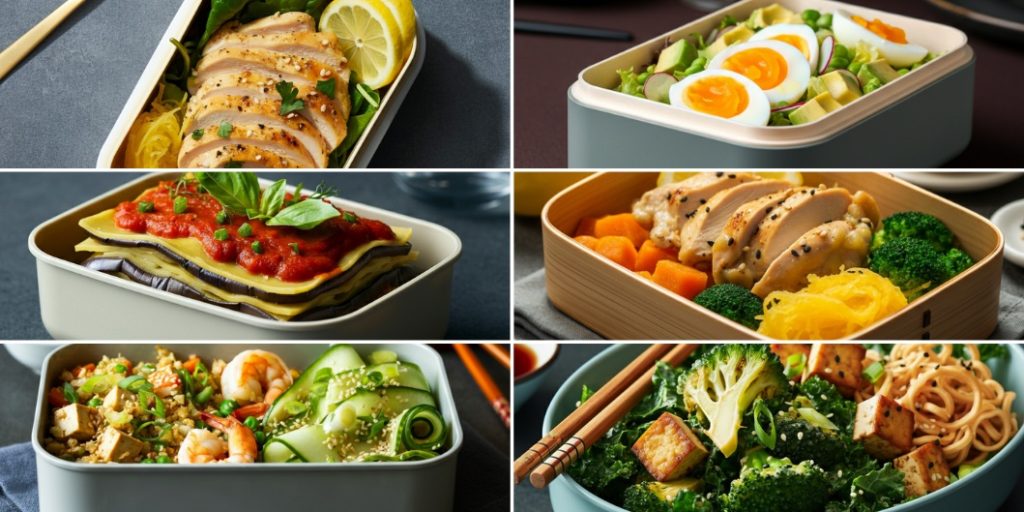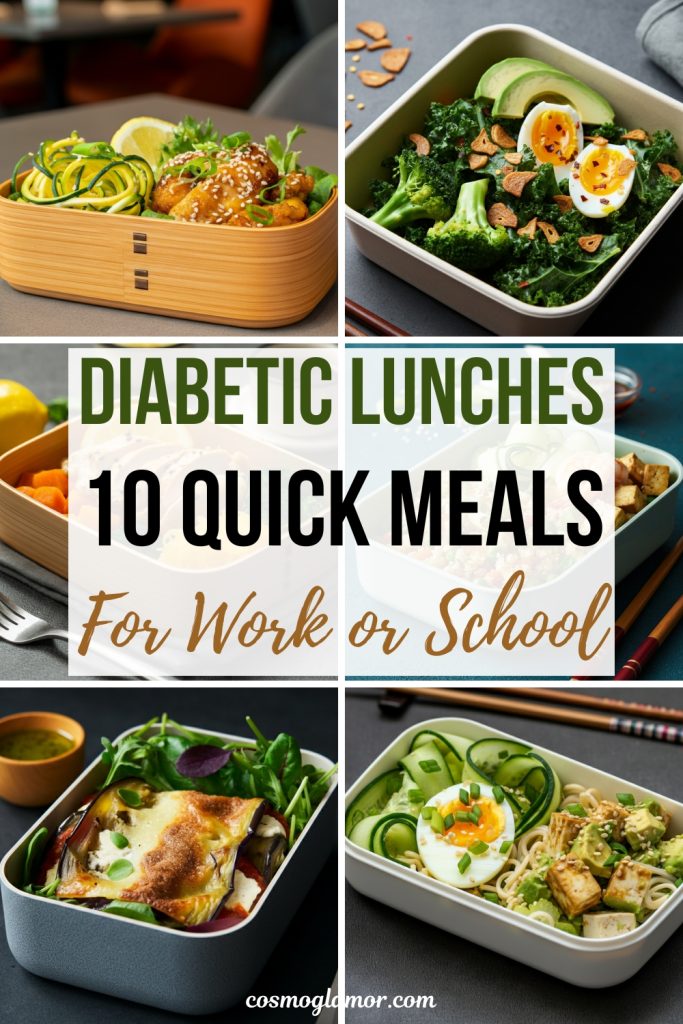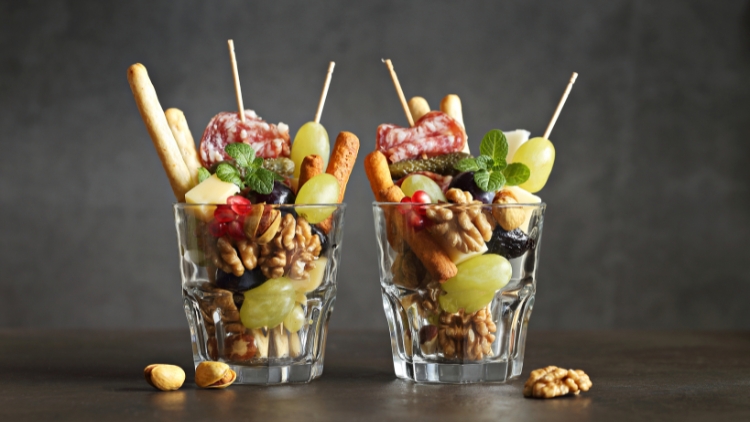Ever found yourself staring blankly into the office fridge, wondering what to eat for lunch? Or maybe you're a student scrambling to pack a quick and healthy meal between classes. If you're managing diabetes, the lunch dilemma can be even more challenging. You need a meal that's not only delicious and satisfying but also helps to keep your blood sugar levels stable.
But who has time to prepare elaborate meals every day? That's where these diabetic-friendly lunch ideas come in. They're quick, easy, and packed with flavor, making it simple to prioritize your health even on your busiest days.
In this article, we'll explore ten delicious and nutritious lunch ideas that are perfect for work or school. Get ready to ditch the sugary snacks and embrace a world of healthy and satisfying midday meals!
Diabetic-Friendly Lunchbox Delights

1. Lemon Chicken & Spaghetti Squash
This refreshing dish features tender spaghetti squash topped with juicy chicken, a zesty tomato-lemon sauce, and wilted spinach. It's a vibrant and flavorful meal that's perfect for a light yet satisfying lunch. The spaghetti squash is a great low-carb alternative to pasta, making it perfect for managing blood sugar, and the chicken and vegetables provide a good source of protein and essential nutrients.
2. Low-Carb Eggplant Lasagna
This is not your average lasagna! This low-carb version swaps out traditional pasta sheets for slices of eggplant, creating a lighter and healthier dish that's still packed with flavor. It's cheesy, satisfying, and reheats beautifully, making it a perfect option for meal prepping. The eggplant provides fiber and nutrients, while the cheese and meat sauce add protein and flavor, all while keeping this dish low in carbohydrates for better blood sugar control.
3. Avocado Egg Salad
This quick and easy recipe takes classic egg salad to the next level with the addition of creamy avocado. Serve it on a piece of toasted whole-grain bread or inside a tender lettuce leaf 1 for a low-carb option. The avocado adds healthy fats and a creamy texture, while the eggs provide protein and essential nutrients. This combination of healthy fats and protein makes this a great choice for stabilizing blood sugar and keeping you feeling full and satisfied.
4. Spinach & Artichoke-Stuffed Portobello Mushrooms
These stuffed mushrooms are a delicious and satisfying vegetarian option. Portobello mushrooms are filled with a creamy spinach and artichoke mixture, then topped with cheese and baked to perfection. Serve them with a big salad for a complete and balanced meal. The mushrooms provide fiber and nutrients, while the spinach and artichoke filling adds flavor and creaminess. This low-carb, high-fiber meal is a great choice for managing blood sugar levels.
5. Salad in a Jar
Salads in a jar are a fantastic way to enjoy a healthy and portable lunch. Simply layer your favorite salad ingredients in a jar, starting with the dressing at the bottom and finishing with the lettuce on top. This helps to keep the salad fresh and prevents it from getting soggy. Add protein like salmon or chicken for a more satisfying meal. These salads are naturally low in carbohydrates and can be packed with protein and fiber, making them a great option for people with diabetes.
6. Low-Carb Fried Kale and Broccoli Salad
This flavorful salad features spicy fried kale, tangy mustard, creamy avocado, hard-boiled eggs, and garlic chips, all tossed in a creamy mustard and mayonnaise dressing. It's a delicious and satisfying way to enjoy your vegetables. The kale and broccoli provide fiber and nutrients, while the eggs and avocado add protein and healthy fats. This combination makes this salad a great choice for managing blood sugar levels and keeping you feeling full and satisfied.
7. Cold Sesame Cucumber Noodles
These refreshing cucumber noodles are a light and flavorful lunch option. They're tossed in a savory sesame dressing and topped with baked tofu for a boost of protein. Cucumber noodles, or “zoodles,” are a great low-carb alternative to pasta, and they're packed with hydrating electrolytes. This low-carb, high-protein meal is a great choice for people with diabetes because it helps to regulate blood sugar levels and prevent energy crashes.
8. Bruschetta Chicken
This flavorful chicken dish features crispy chicken breasts topped with a vibrant bruschetta mixture of tomatoes, basil, and balsamic vinegar. It's a simple yet satisfying meal that's perfect for a quick and healthy lunch. The chicken provides a good source of protein, while the bruschetta topping adds flavor and antioxidants. This dish is a great option for people with diabetes because it's low in carbohydrates and high in protein, which helps to stabilize blood sugar levels.
9. Low-Carb Burrito Bowls
These burrito bowls are a healthy and customizable lunch option. They're made with fresh and flavorful ingredients like cauliflower rice, grilled chicken or beef, black beans, salsa, and avocado. You can easily adjust the ingredients to fit your dietary needs and preferences. The cauliflower rice is a great low-carb alternative to traditional rice, and the protein and fiber from the beans and meat help to keep you feeling full and satisfied, making this a perfect lunch choice for managing blood sugar levels.
10. Cauli Shrimp Fried Rice
This grain-free fried rice is a delicious and healthy alternative to traditional fried rice. It's made with cauliflower rice, shrimp, vegetables, and a flavorful sauce. It's a quick and easy meal that's perfect for a light yet satisfying lunch. The cauliflower rice is low in carbohydrates and high in fiber, while the shrimp provides a good source of protein. This combination makes this dish a great option for people with diabetes because it helps to regulate blood sugar levels and keep you feeling full and energized.
These ten lunch ideas demonstrate that managing diabetes doesn't mean sacrificing taste, variety, or convenience. With a little planning and these delicious recipes, you can enjoy a healthy and satisfying lunch every day, whether you're at work, school, or on the go.
Tips for Diabetic-Friendly Lunches
- Prioritize protein and fiber: Include a good source of protein, such as chicken, fish, beans, or tofu, in your lunch to help stabilize blood sugar levels and keep you feeling full. Add fiber-rich foods like vegetables, fruits, and whole grains to further support blood sugar control and promote satiety.
- Choose healthy fats: Incorporate healthy fats, such as those found in avocados, nuts, and seeds, to enhance flavor and provide sustained energy.
- Watch portion sizes: Even healthy foods can contribute to blood sugar spikes if eaten in excess. Be mindful of portion sizes to help manage your blood sugar levels.
- Pack your lunch: Packing your lunch gives you more control over the ingredients and portion sizes, making it easier to make healthy choices.
- Plan ahead: If you know you'll be short on time, prepare some lunch components in advance, such as chopping vegetables or cooking a batch of protein.
By incorporating these tips into your routine, you can make healthy and delicious lunches a regular part of your diabetes management plan.
Important Note: While these recipes and tips are generally considered suitable for people with diabetes, it's always advisable to consult with your doctor or a registered dietitian to ensure they fit into your individual meal plan and dietary needs.









12 Responses
Salad in a jar? I’m intrigued, but also picturing myself trying to eat this gracefully at my desk without spilling dressing all over my keyboard. 😂 Has anyone mastered the art of jar-salad eating? Also, any tips on what kind of jar works best? I’m envisioning a wide-mouth mason jar, but maybe I’m overthinking this… #LunchProblems
Melissa, you’re not alone! 😂 Jar salads can be a bit tricky at first, but they’re worth it! A wide-mouth mason jar is definitely the way to go. The key is to layer it properly: dressing on the bottom, then hearty veggies, then grains/protein, and finally the delicate greens on top. When you’re ready to eat, give it a good shake (lid on tight, obviously!) or pour it into a bowl. You’ll be a jar-salad pro in no time! 😉
These recipes sound great, but I’m a notoriously picky eater. Eggplant lasagna? I haven’t touched eggplant since I was a kid and forced to eat it. 🤢 Any suggestions for substitutions in these recipes? I’m open to trying new things, but baby steps, people! Also, are there any good resources for finding more diabetic-friendly recipes that don’t involve, you know, things I might have found traumatizing in my childhood?
Jessica, I hear you! Eggplant isn’t for everyone. Luckily, you can easily swap it out in the lasagna. Try using zucchini or even portobello mushroom slices instead! For other recipes, feel free to get creative with substitutions. Don’t like artichoke? Try spinach or bell peppers. Not a fan of tofu? Use chicken or chickpeas. As for resources, there are tons of great websites and cookbooks dedicated to diabetic-friendly meals. Diabetes Food Hub and EatingWell are good places to start. And don’t worry, you don’t have to eat anything you find traumatizing! 😂 There’s a whole world of delicious, diabetic-friendly food out there waiting to be discovered.
These recipes sound delicious, but “low-carb” usually means “low-flavor” in my experience. 😅 Also, I’m not a huge fan of cauliflower. Are there any substitutions for the cauliflower rice that are still diabetic-friendly? And is it really possible to make lasagna without pasta and have it still taste like lasagna? I’m skeptical! 🤔
Hey Lisa, I hear you! Low-carb doesn’t have to mean bland, I promise! There are tons of ways to add flavor to these dishes, like spices, herbs, and flavorful sauces. As for the cauliflower rice, you could try using finely chopped broccoli or even shirataki noodles, which are super low in carbs. And about the lasagna, I was skeptical too at first! But the eggplant really does a great job of mimicking the texture of pasta, and with all that cheesy goodness, you won’t even miss the carbs! 😉 Give it a try, you might be surprised!
Okay, these lunch ideas sound great, but I’m a busy mom with a full-time job. I barely have time to eat lunch, let alone prep all these ingredients. Are these recipes actually realistic for someone with a hectic schedule? Also, my kids are picky eaters, will they even touch these healthy options? 🤨
Emily, I totally get it! Life gets crazy. The good news is that many of these recipes can be prepped ahead of time, like the salad in a jar and the burrito bowls. You can also make extra portions for dinner and have leftovers for lunch the next day. As for the picky eaters, maybe start with the more familiar options, like the bruschetta chicken or the avocado egg salad. You could also try getting them involved in the cooking process. Sometimes, when kids help make their food, they’re more likely to try it! 👍 Good luck!
This article is really interesting, but I have a question about the leafy greens. My doctor told me I should limit them because I’m on a blood thinner. The article says they’re good for blood sugar, but wouldn’t the Vitamin K be a problem for me? I’m confused! Also, the article mentions eating spinach in omelets… I’ve tried that and it just ends up tasting like grass, any tips for making it taste better?
Hi Brooklyn, you’ve hit on a really important point! It’s true that leafy greens like spinach and kale are high in Vitamin K, which can interfere with blood thinners like warfarin. It’s always best to follow your doctor’s advice in these situations. They know your specific medical history and can give you the most accurate guidance.
That said, it doesn’t necessarily mean you have to avoid leafy greens entirely, but moderation and monitoring are key. You could discuss with your doctor whether smaller, consistent amounts of greens are acceptable, and how to adjust your medication accordingly. There are also some other greens that are relatively lower in Vitamin K, such as romaine lettuce.
As for the spinach in omelets, I hear you! Spinach can be a bit bland on its own. Try sautéing it first with a little garlic and olive oil before adding it to the omelet. This will wilt the spinach and give it a more savory flavor. A pinch of salt, pepper, or even a dash of red pepper flakes can also make a big difference. Another trick is to mix it with a stronger-flavored cheese, like feta or goat cheese. Don’t give up on it yet, there’s a tasty spinach omelet out there with your name on it!
Okay, the whole ‘dark chocolate is a superfood’ thing seems a bit too good to be true. Don’t get me wrong, I love chocolate, but isn’t this just an excuse to eat more of it? And the article mentions a ‘small square’ a few times a week – who actually does that?! Also, the avocado section got me thinking… is guacamole considered a healthy snack, or is it just a way to eat a bunch of chips? 😂
Hi Tiffany, you’re right to be skeptical—the dark chocolate recommendation does often raise eyebrows! The key is the type and quantity. We’re talking about dark chocolate with at least 70% cocoa content, which is where the beneficial antioxidants (flavonoids) are found. It’s definitely not a free pass to indulge in a whole bar. The ‘small square’ (about 1 ounce) is a guideline, and it’s meant to be savored, not scarfed down. It is true, sticking to that small amount is tough!
And about the guacamole… it’s a bit of a gray area. Avocados themselves are nutritional powerhouses, packed with healthy fats and fiber. But, you’re right, guacamole is often paired with not-so-healthy chips. The chips can quickly turn a healthy snack into a calorie bomb. For a healthier option, try using veggie sticks (like carrots, celery, and bell peppers) for dipping instead of chips. You can also make your guacamole with less salt and more of the good stuff, like onions, tomatoes, and cilantro, to boost the nutritional value. Guacamole can be a healthy snack, but like most things, portion control and mindful choices are important!